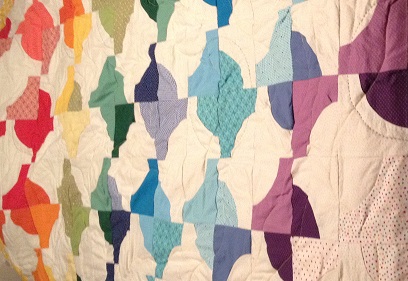My friend P got married in January. P was very good friends with my friend F who died – the friend I made my very first quilt for. (In fact, and I didn’t know this in advance, F’s mother and sister attended P’s wedding, and it was so wonderful to see them. They’re lovely people.) I decided for P’s wedding quilt I wanted to use a pinwheel pattern to mirror what I had made for F. Fortunately, one of my quilting books actually has a pattern, which is far easier than what I remember doing the first time. (I think the first time I cut out dozens of tiny triangles – very time consuming.) The book is “Sensational Small Quilts,” and the instructions are “Glowing Stars,” written by Priscilla Bianchi. The book recommended using 3/4 yard cuts of 34 different prints, 17 of one type and 17 of another type. I asked P about colors and she said their favorite colors are blue and green. That’s perfect, since I have tons of green and blue fabrics. I followed the directions in the book, which said to cut two 3” strips from each print. I think you needed to cut the 3″ strips along the long edge (since most fabrics are approx. 40-44″ wide) instead of along the 3/4 yard edge, so my strips weren’t long enough. (In hindsight, this makes a lot of sense. I thought some of the instructions were unclear but that misunderstanding is definitely my fault.) I ended up with 68 strips total. Then, I matched up the blue and green prints. I sewed the strips with the green on the left and the blue on the right (always matching up the same prints).


Next, I cut equilateral triangles from the strips. The book provided a template that I traced onto a piece of light card stock (I used one of those postcard things advertisers send in the mail). Sewing the strips together and cutting the equilateral triangles saved a lot of time. There was less to trace. The instructions said to cut nine triangles from each set of strips. Since, as I’ve mentioned, I cut my strips wrong, I couldn’t make nine triangles out of each set. I could only make six to eight triangles from each set. I ended up having to go back and sew the remnants from my strips together to make more triangles. (I’m not sure that even makes sense. If you don’t make the same mistake I did, you won’t have this problem!) I should have realized that cutting only six triangles instead of nine would yield fewer triangles than I needed, but I wasn’t thinking about it.



I took each set of six triangles from matching blue/green strips and sewed three into one half of a hexagon and three into the other half, like below. The green halves of the triangles form the pinwheels. (The instructions call them stars.)


At this point I realized I still didn’t have enough hexagons for the size quilt I wanted to make. I cut more strips of blue and green, and then more triangles. Finally I had enough hexagons to make an acceptable quilt. (It’s still on the small side, but most wedding presents I make for people are lap-sized quilts.) The way to sew the hexagons is in horizontal rows. I laid all the half hexagons out on my couch and spent some time rearranging them, trying to figure out the best lay out.



The book provided instructions for a border. As you see above, the hexagons don’t form a solid vertical border, so you need small triangles on the edge of each row. I used navy, as the book instructed, since it provided a nice contrast with the brighter blues and greens in the hexagons.

The quilt still wasn’t as big as I wanted. I also knew I wanted to do some hand quilting – their names and maybe the date of the wedding and some meaningful phrases or something – so I added an extra border pieced from teals and greens. I took three teal fabrics, which I think were all from the same set of fabrics, and I cut them into strips. Then I sewed the strips together, and cut horizontal strips from that to make a striped border. I added greens to the corners of each border.


Next time I’ll talk about the quilting I did. Yay quilting!























